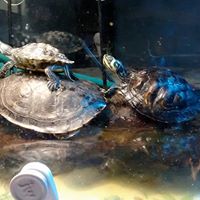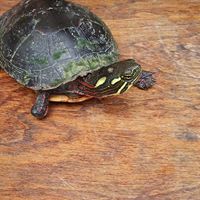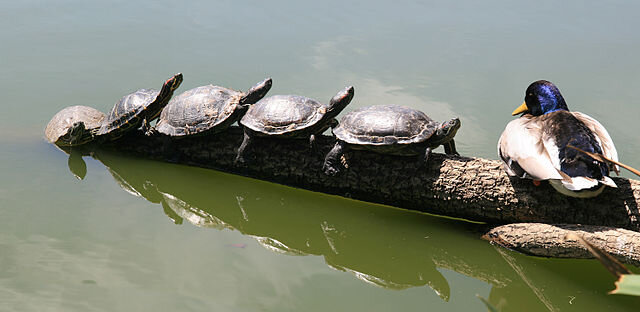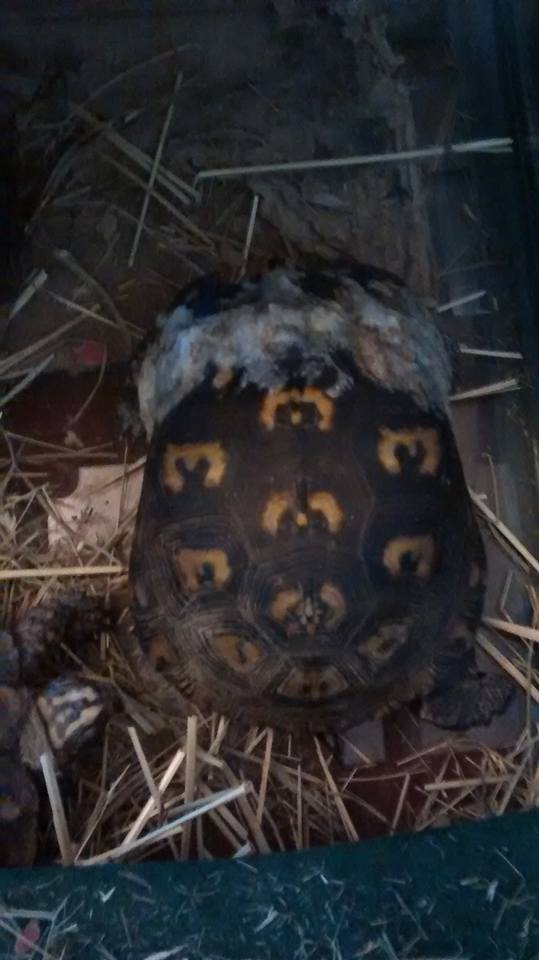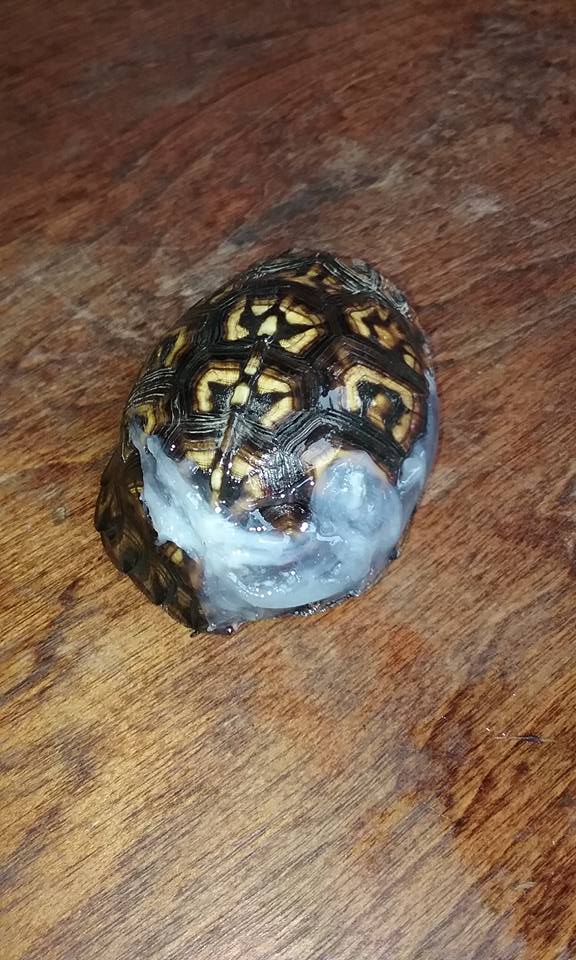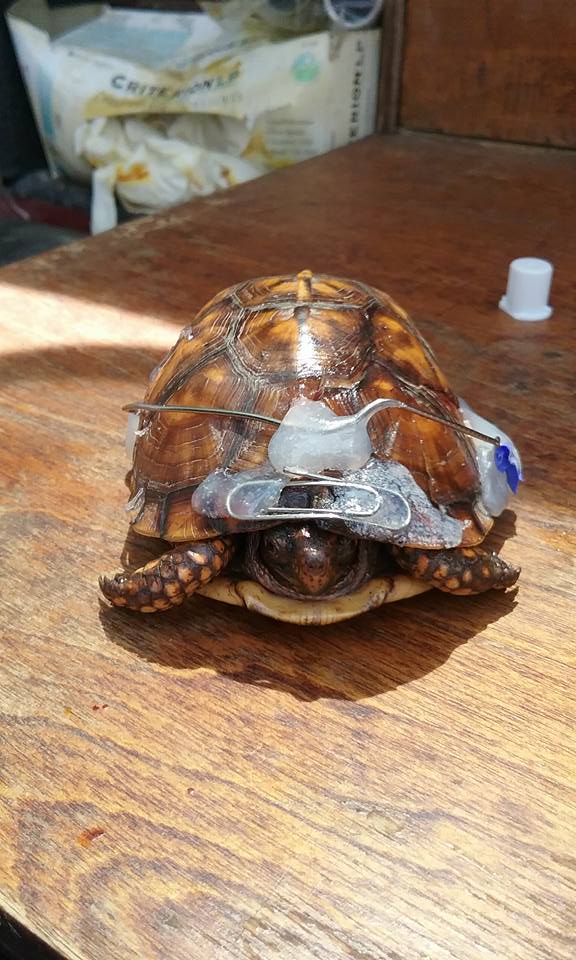Updated January 30, 2021
Turtles are easy to recognize reptiles that are famous for carrying their house everywhere they go. They are often portrayed as slow-moving and dim-witted in stories and cartoons. But they are faster and more intelligent than given credit for!
In Kentucky, we have 14 species of turtles. All of our turtles are aquatic and live in water except for one, the Eastern Box Turtle.
A Turtle Is a Tortoise Is a Terrapin
Turtle is the common name for our friends with a shell. The different names came about from where the animal lives. Technically tortoises are turtles that live on land and terrapins are freshwater turtles.
Turtles, tortoises, and terrapins are all part of the same family. Scientists call them chelonians.
Chelonians are reptiles that have scales and lay eggs. They belong to the order Chelonia, which comes from the Greek word for turtle, chelone.
They are ectotherms (cold-blooded) which means their body temperature changes based on the surrounding environment. Like other reptiles, turtles breathe air and lay soft, leather-like eggs.
Fox Run EEC Education programs teach about turtles and other wildlife
Life As A Turtle
Brumation
During the winter months, turtles hibernate, or more accurately they brumate. Brumation is an adaptation that allows cold-blooded animals to survive lower temperatures.
During this time heart and respiratory rates drop and the animal becomes lethargic. In Kentucky, our box turtles will dig down in a burrow under the ground to protect themselves from the extreme winter temperatures.
Aquatic turtles, like our Red-eared Slider, also brumate but interestingly, they do so under the water. The slider will dig down into the mud at the bottom of the pond. Their body functions decrease to a point that they need very little oxygen to survive.
Some aquatic turtles can take in air through their cloaca. This organ is primarily used for the secretion of waste.
Basically, it’s their rectum. In turtles that brumate under the water or live in deep water (sea turtles) this provides a way to get oxygen when their bodies can not get to the surface.
Read our blog about hibernation, brumation, and torpor.
Turtle Senses
Do Turtles See Well?
Turtles have good vision. They use their vision to hunt or locate food. Vision is also a sense used to find a mate.
Aquatic turtles need to be able to see under water and on land. They have specialized eyes so they can do this.
Turtles have flat corneas and spherical lenses. This shape reflects light in such a way that they see quite well underwater.
Interestingly turtles have been found to be far-sighted if they are looking at something underwater. When on land the turtle tends to be more near-sighted. This makes sense based on the type of food they would be after.
Can Turtles See Colors?
Yes, turtles can see a broad range of colors including ones that humans can’t. Studies have shown they see shades of red, yellow and orange quite well. This color range makes sense when it comes to finding certain types of foods.
For instance, turtles can see the color red well and can see more shades of red than humans. And guess who loves strawberries? Our box turtles!
Can Turtles See in the Dark?
Yes, they can however not as well as in the daytime. Like humans a turtle’s pupils get bigger when it is dark out to allow more light to enter.
Turtles lack the layer of eye tissues called tapetum lucidum which allows many animals such as cats to see well at night. Humans don’t have a tapetum lucidum either!
Hearing
Do turtles have ears, and can they hear? Like most reptiles, turtles do not have external ears, the part we think of as hearing. However, turtles do have some sense of hearing.
While they lack an external ear, they do have a inner and middle ear which detects vibrations. A tympanic membrane which is covered by a thin layer of skin, acts as an ear drum.
Turtles have a limited range and hear low frequency sounds best. Smell and sight are relied on more that hearing to find food.
Their ears also function to give them balance.
Sinse hearing is not as strong a sense in turtles they don’t dedicate much brain power to perceiving sounds.
Can turtles communicate with each other?
Yes, turtles do communicate with each other. Young turtles make sounds that can be detected by adults. They can also detect the vibrations made by predators.
One studied showed how Gopher Turtles which are found in the southern United States make grunting sounds that can be heard by other Gopher turtles.
Smell
Turtles have a highly developed sense of smell and the olfactory parts of their brains are well developed. Like snakes, they have Jacobson organs which detect particles in the air.
Turtles use their sense of smell to locate food as well as to locate a mate. Female turtle send out pheromones that tell the male turtle she is looking for that special friend.
Some turtles can even produce smells! The musk turtle has glands which produce a musk. This makes them the skunks of the reptile family.
Barbels
Barbels are a sensory organ located on the chin of many turtles.
Touch
Turtles have a nervous system just like mammals do. If you pick up a turtle and run your fingers along their shell they can feel your touch. Even though the turtle’s shell is hard there are thousands of tiny nerves that go throughout the shell and the rest of the body.
Do Turtles Feel Pain?
Yes, those nerve endings send reports to the brain. The turtle’s shell and skin are sensitive to touch.
Never carve your initials or a design in a turtle’s shell. Not only is the crewel but the turtle can get an infection and die.
Homing Instinct
In the spring, turtles come out of brumation and start moving around. They see that blacktop road as a nice warm pathway! If you see a turtle crossing the road, and you can safely pull over, you can give them an assist. Take them into the direction they were going and put them down facing away from the road.
Remember to wash your hands after handling a turtle.
Turtles have a homing instinct which you can read about in our blog There Is No Place Like Home.
Where Do Turtles Live?
Box Turtles live in fields and marginal woodlands. Aquatic turtles spend the majority of their time in the water. Typically in slow-moving rivers and ponds. They do come out to sun themselves, lay eggs, and may travel overland to seek another water source.
Not about turtles but a fabulous book by my reptile hero, David Steen, who also works with sea turtles. Learn the truth about snakes!
Can Turtles Run
Turtles do not run in the sense that a mammal does because their legs are shorter and their shell limits movement.
That said you may be surprised how fast a turtle can move.
Here is a video of Kuda in my yard. Kuda is a River Cooter, an aquatic species that can also move on land. Also, poor Kuda is blind in one eye and has poor vision in the other.
Eastern Box Turtle
Eastern Box Turtles are territorial and often live within 1/2 mile of where they were born. Removing a box turtle from its territory causes confusion, inability to find food sources, and conflict with other turtles.
So "rescuing" that box turtle from an urban area and taking it 10 miles away to grandpa's farm is actually causing the turtle more harm than good.
They have a dome-shaped shell. The top is called the carapace and it is made of bony plates that are fused to the underlying ribs and Vertebrata. (This is why, contrary to Hannah Barbera, turtles can not walk out of their shell).
Many people think the turtle does not feel pain and sometimes people are cruel and carve words in the shell. The shell has blood vessels and nerve endings so a broken shell does cause the turtle pain.
The bottom part of the shell is called the plastron which connects to the carapace. The plastron has hinges in front and back which allows the turtle to pull in his body and be protected. That in addition, to his domed body shape helps protect himself from predators.
Kentucky Aquatic Turtles
Kentucky has 13 species of aquatic turtles and monitors six species of turtles for conservation efforts due to habitat loss, water pollution, and population decline.
The Smooth Shell, Alligator Snapping Turtle, and Mississippi Map Turtle are rare in Kentucky and the Eastern Mud Turtle, False Map Turtle, and the Midland Smooth Softshell have been in decline.
Many endangered turtles live in Western Kentucky in and along the tributaries and lakes of the Mississippi watershed. Pesticides from agriculture are very detrimental to aquatic life. Raising food organically without the use of chemicals saves lives. Read 10 Reasons To Go Organic.
The Common Snapping Turtle
The Common Snapping turtle is indeed common in Kentucky and lives in ponds, lakes rivers, and creeks. Anywhere there is abundant water.
They live in all states east of the Mississippi and many great plains states down into Central America.
The Snapping Turtle has a bad reputation since it can act in an aggressive manner when provoked. They are sometimes found crossing roads or going across yards as they move from one water source to another.
Snappers can travel long distances over land to mate or lay eggs. They will also travel due to habitat loss and water pollution, two things that threaten their existence.
The Snapping turtle plays an important part in our local ecology. Snappers are omnivores and eat both plants and meat. Aquatic plants, frogs, snakes, and baby waterfowl are all part of their diet. They also eat carrion in and around the water.
Photo by herpetologist Kurt Buhlman
They are also scavengers and will eat dead fish and frogs. They play an important role in keeping their water environment free from debris.
Like other turtles, the eggs from the Snapper provide food for many other species. Fox, Skunk, minks, and Raccoons, all will eat the eggs.
In addition, many birds such as herons and hawks as well as large fish and bullfrogs will eat the hatchlings. Not too much besides man eats the adult turtles.
When hatchlings are born they are only an inch long and have poor swimming skills. The young have to cling to plants so they do not drown.
Difference between the Common and the Alligator Snapping Turtle
The common snapper gets to be about 40 pounds not quite as big as its cousin the Alligator Snapping turtle.
Here is an interesting picture of Alligator and Common snapping turtle hatchlings. The Alligator snapping turtle has a bumpy, rigid shell. The common snapper has a smoother shell with distinctive triangular plates at the rear.
Another difference is the eyes. The eyes on the common are on the side of the head and are visible when you look down at the animal.
The eyes of the alligator snapping turtle are laterally positioned and not visible when you look down on them.
John White, Murray State University
Alligator Snappers have a unique way of catching fish. Their tongue has a worm-like growth that is used to lure fish right into their jaws!
You can read more about the endangered Alligator Snapping turtle in our blog Slowly Walking Towards Extinction
Red Eared Slider
The Red-eared Slider lives in ponds throughout the state and is often the turtle you see relaxing on a floating log in the sun. They have a red slash on their checks thus their name. There is also a lesser-known yellow eared slider with a similar yellow slash.
Many turtles such as the Red-eared Slider are declining in number due to the pet trade. In the United States, it is illegal to sell a turtle if the carapace is less than 4 inches in length.
In Kentucky, it is illegal to remove turtles from the wild and keep them as pets, buy or sell them. It is also illegal to remove turtles from the wild and use them in turtle races.
River Cooter
The River Cooters are found throughout the south. In Kentucky, they are found mostly in the western part of the state along the Mississippi watershed. Cooters like slow-moving rivers best.
Cooter love to bask in the sun and Kuda is often basking in his tank with Red our Red Eared Slider. They are a laid back turtle and not aggressive towards others. They can move with surprising speed as you can see in the above video.
The River Cooter is an omnivore. They eat a variety of aquatic plants, small fish, and carrion. They are diurnal which means they sleep at night as we do.
The River Cooter has left a fabulous mark on American history. During the times of slavery in our country, many slaves were not provided with adequate food or hunting weapons.
One food they could catch was turtles. Because Cooters grow large and are not aggressive they were easy for slaves to catch to feed their families.
In fact, their name comes from the African word "kuta" which means "turtle". That’s how our “Kuda” got his name!
Eastern Mud Turtles
Eastern Mud Turtle Photo by LA Dawson
The Eastern Mud Turtle is a common but not often seen turtle and is found throughout the state. They are small with an average shell size of four inches.
They prefer small ponds with lots of vegetation. These turtles like to hide down in the mud among the plants.
African Spurred Tortoise
One problem we have in Kentucky deals with the African Spurred Tortoise. They are not a native species.
This tortoise is from the Sahara Desert in Africa and is popular in the pet trade. They are sold as small babies.
What people do not realize is that they are the third-largest land tortoise and grow to 150 pounds and measure 30 inches across.
This species requires specialized food, temperature, and space. If you look at the picture below, this tortoise has a problem called pyramiding. Pyramiding is the abnormal development of the shell. It is caused by poor care, malnutrition, and an improper environment.
In Kentucky, it is a common problem for these turtles to become abandoned along the roads.
This is an African Spurred Tortoise who was found by our Fish and Wildlife Officer wandering the roads. He was taken to Arrowhead Reptile Rescue in Cincinnati.
How To Manage Turtle Related Problems
Turtles are usually not a threat to the live fish in your pond. They eat mainly dead fish but some species eat the fry or baby fish. Most turtles are not fast enough to catch adult fish.
Snapping turtles may eat young waterfowl. Sometimes turtles can become overpopulated in a pond and cause problems if they are eating too many fish or young waterfowl.
Turtles can be caught in a trap and relocated to another pond. Kentucky Fish and Wildlife offers some solutions to pond problems.
Check out my children's book about our own Goober Goose
Fun Turtle Facts
The Eastern Box Turtle can live 100 years, although the average is 55
The first turtles occurred 200 million years ago, before dinosaurs
The biggest turtle was an Alligator Snapping Turtle that weighed 316 lbs.
The Common Musk turtle has glands that secrete a stinky oil
The Soft-shell Turtle has a leathery shell instead of a hard shell
This outdoor box turtle enclosure was made for us by Girl Scout Troop 1830. Now our Eastern Box Turtles can enjoy being outside during the summer months!
Turtle Rehabilitation
At Fox Run Environmental Education Center we provide wildlife rehabilitation for 10 -15 Kentucky turtles every year. As we all know, turtles have a crossing the road obsession and are frequently run over by cars.
I have worked with my vet, Dr. Glaza, on finding best practices to glue, staple, and clamp our friends back together. We have had lots of successful turtles who have been able to be released.
Turtles have a homing instinct so we always release them near by where they were found.
Turtles As Pets
The turtle population in Kentucky and all over the world has been dramatically reduced by the pet trade. Read our blog Kentucky Turtles – slowly walking towards extinction?
Do not remove turtles from the wild. It is a selfish act.
When turtles are removed from the wild they can no longer behave naturally which not only means taking away their freedom but not allowing them to reproduce and thus you are contributing to lowering the population.
There are many turtle and tortoise breeds that are legal to own. Do your homework! Research how big the animal will get. If you live in an apartment a larger breed is not practical.
Turtles often have very exact humidity and light needs. Make sure you can provide for them in the manner that is best for their health and happiness.
Most of all make sure you buy from a licensed breeder to ensure that your new friend has not been removed from his natural home. Even better adopt a turtle that has been abandoned or surrendered. Arrowhead Reptile Rescue in Cincinnati has many reptiles in need of good homes.
If you are going to have a (legal) pet turtle we suggest that you keep them in the biggest tank possible. Turtles do like to move around and it is very unhealthy for them to be stuck in a tiny ten-gallon aquarium! A turtle the is 4 - 6 inches across needs at least a thirty-gallon tank. One that is 6-8 inches needs a 50-gallon tank.
Turtles in Literature
Turtles are very popular animals in literature. From pop culture back to ancient mythology and as wise old teachers. Turtles are often seen as easygoing, patient, and wise due to their long lifespan and sturdiness.
Many religions have turtles that carry the world on their backs.
In Greek mythology, the tortoise was an attribute of the goddess Aphrodite. She was often depicted with a turtle at her feet.
In Hinduism, the world is believed to rest on the back of four elephants who are standing on a turtle’s shell. Kurma is one avatar representing Vishnu. Sri Kurman Temple located in India is dedicated to Kurma.
Many northeastern Native American tribes have turtles in their origin stories and viewed as elders. The Earth Diver tells about how the Great Spirit sent an animal into the waters to find some earth. That earth was then placed on the back of a turtle which is how we got the land.
In Nigeria, Ijapa the tortoise is a trickster that often gets into trouble. He is seen as slow but smart and often manipulates himself out of dangerous situations.
Many people are familiar with Aesop’s Fable of the Tortoise and the Hare. The tortoise is slow, but he is clever and ultimately wins the race.
Paulette Bourgeois wrote a wonderful series for young children based on the character Franklin the Turtle.
I read one of them in my video and introduce two of our education box turtles.
And who can resist Dr. Suess’s Yurtle the Turtle who’s character Mack was wise beyond his years.
If your looking for a good natural history book this ia a good one
Ame Vanorio is a former science and special education teacher, the director of Fox Run Environmental Education Center, and a licensed wildlife rehabilitator. She teaches classes locally and online about organic gardening, green building, living off-grid, and wildlife conservation. She lives off-grid on her Kentucky farm with a myriad of domestic and wild animals.








